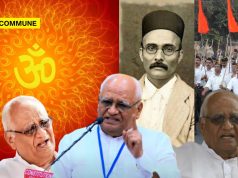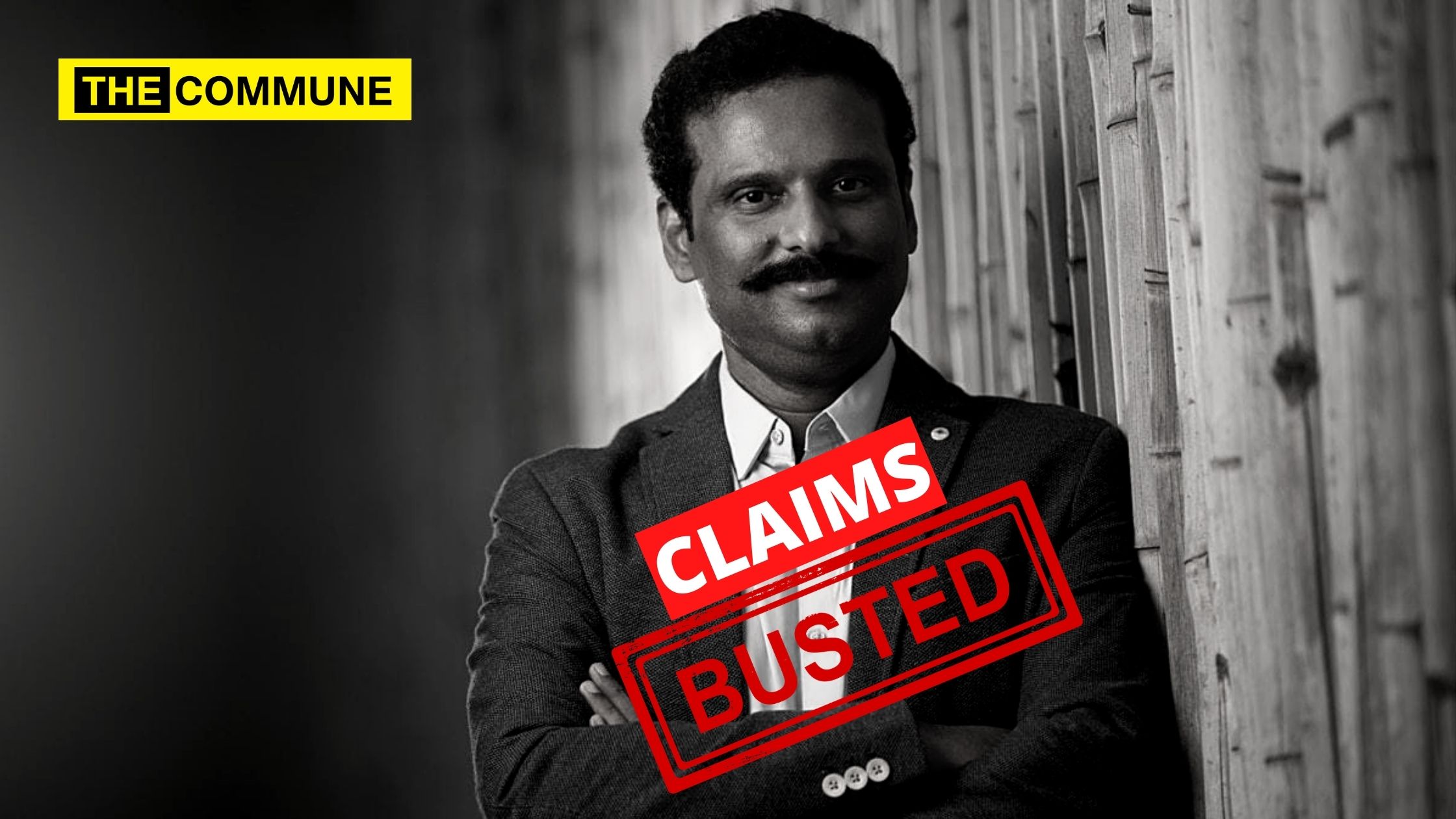
It seems like the DMK has found its new poster boy in IT entrepreneur Mr. Suresh Sambandam, to sell its old rotten stock about how it was because of the party and its brand of politics that Tamil Nadu’s economic and social development indices are ahead of other states in the country.
In his interview to Behindwoods Youtube channel with ‘Neeya Naana’ Gopinath, this man repeats the same half-truths and lies that has been peddled by the ‘Dravidian’ ideologues for years and because it comes from a seemingly apolitical person, people tend to buy this story.
However, the man is nothing more than a Murasoli reader who is wise enough to fabricate data in order to portray DMK as the pioneer of development politics.
In this article we bust some of the claims made by him in the interview that has been going viral.
#1
The title of the video “The rising Bill Gates from Tamil Nadu” is in itself laughable.
In the interview, both Gopinath and Suresh refer to the latter’s company as worth ₹1000 crores. Here are some numbers – Orangescape, which owns the product Kissflow was founded in 2003. It had a consolidated revenue of ₹28 crores for the financial year of 2019 and employs around 150 people despite doing business for close to two decades. If this gentleman is compared with Bill Gates, where would Shiv Nadar (Founder of HCL) or R.G. Chandramogan (Founder of Hatsun Agro Products) stand?
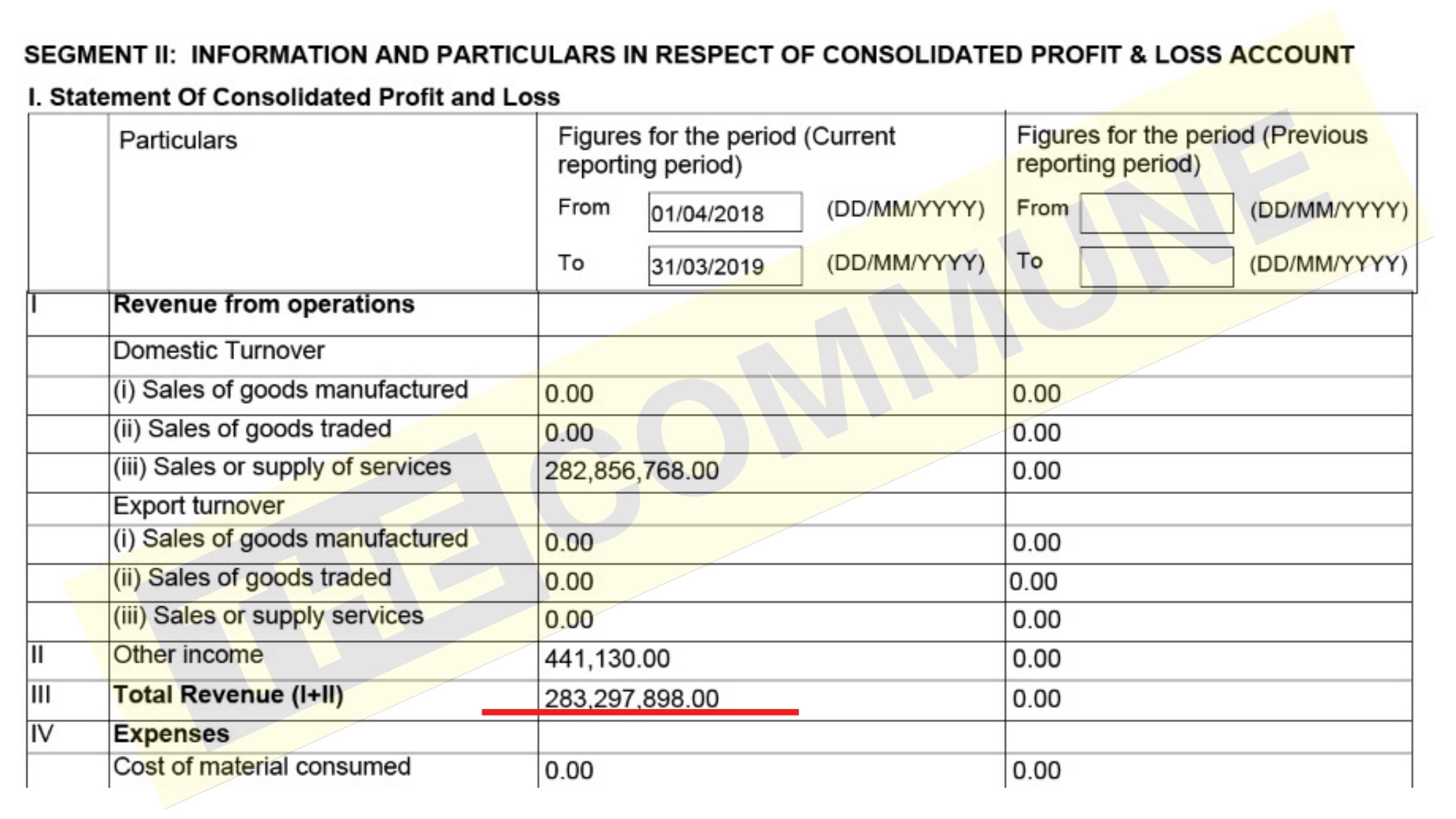
#2
Suresh Sambandam claims in the interview that Kamarajar defeated Rajaji in the Tamil Nadu Congress President elections. Listen to the video from 3:15.
The truth is that they never contested against each other. With this claim, Suresh Sambandham has exposed his shallow knowledge on history by confusing this election with the incident where Congress MLAs voted to elect the new Chief Minister after Rajaji’s resignation in 1954.
It was C. Subramaniam, who contested against Rajaji and that contest too was only a formality, as per Congress norms then. This information can be found in Rajmohan Gandhi’s book on Rajaji.
#3
He once again proved to be a reader of Murasoli by making absurd claims that it was Periyar who had asked Kamarajar to contest the Gudiyatham by-elections and that the latter won because Periyar had campaigned.
We don’t know from where Suresh Sambandam learnt history but here is the truth.
Gudiyatham was then a Congress stronghold. Before 1961, some Assembly and Parliamentary constituencies were marked as two member constituencies which were abolished through The Two- Member Constituencies (Abolition) Act, 1961. Back then, Gudiyatham was a 2 member constituency and both the MLAs elected in 1952 were from the Indian National Congress. Here is the data from Election Commission of India’s website.
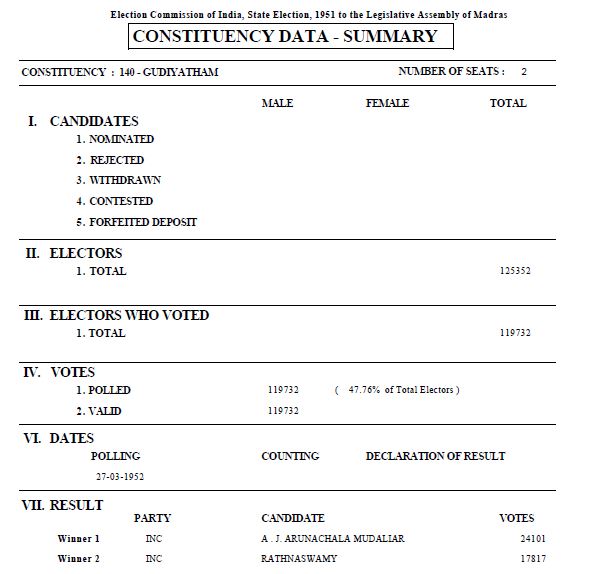
One of the seats in Gudiyatham fell vacant and by-elections to it were conducted in 1954 in which Kamarajar decided to contest. Kothandaraman of Communist Party had contested against Kamaraj and lost with a margin of 38212 votes.
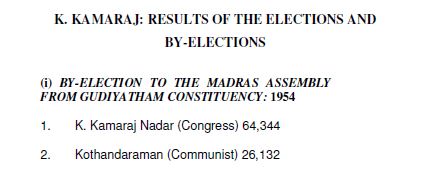
Periyar’s Dravida Kazhagam, had extended support to the Communists in the 1952 elections in order to defeat the Indian National Congress which it claimed was a Brahmin dominated party.
It must be noted that both the DMK and DK at that time were advocating secession from India and were dead against INC. But Periyar’s influence among voters at that point of time was negligible and Kamarajar was the tallest leader from Tamil Nadu in 1954.
To say that the powerful leader of ruling INC in Tamil Nadu won because of Periyar is as ridiculous as saying Karunanidhi won in Tiruvarur because of Veeramani’s campaigns.
Read some actual history Mr. Suresh Sambandham, not the ones getting churned at Periyar Thidal or Murasoli.
#4
Suresh claims that Tamil Nadu’s progress on social indicators is better than other states (read BJP ruled Uttar Pradesh, Bihar, Madhya Pradesh, Gujarat, etc).
In 1961, the literacy rate of Tamil Nadu was 36.39% and was already the 2nd highest in India. So, we were already ahead of the line. The DMK came to power for the first time only in 1967. Literacy rates of Uttar Pradesh and Bihar in 1961 were 20.87% and 21.95% respectively. During the past 50+ years, Tamil Nadu is only maintaining the lead to some extent. In fact, the incremental change in literacy percentage for the past 50 + years is 43.7% which is much lower than that of Uttar Pradesh, Gujarat and Bihar.
It is important to note that states like Uttar Pradesh, Bihar, etc has a much higher population than Tamil Nadu. Uttar Pradesh has thrice the population of Tamil Nadu, and for every 1 percentage increase, one needs to educate 3 times more people.
Also, just as Mr. Suresh says, literacy is not a good measure to evaluate educational achievement. According to Annual Status of Education Report 2018, only 40.7% of Class 5 children are able to read a simple story in Tamil that is of grade 2 level. This is much below the national average of 50.3%. In case of Uttar Pradesh, 52% of Class 5 children are able to read the same story in Hindi.
#5
Ever since the National Education Policy 2020 was rolled which states one of its objectives as increasing the Gross Enrolment Ratio (GER) of the country to 50% by 2025, the Dravidian chauvinists have been thumping their chests about how Tamil Nadu is 15 years ahead of rest of the country.
It is laudable that Tamil Nadu has a high GER. But it is just one of the parameters that talks about how many are currently enrolled in college education. However, the quality of the graduating students matter.
Tamil Nadu graduates lag behind their counter parts in the Hindi heartland states like UP, Bihar, Rajasthan, Jharkhand or even neighbouring states like Telangana and Andhra Pradesh for that matter.
Take for instance the Civil Service Examinations conducted by the Union Public Service Commission, a body that still holds the reputation of conducting recruitments in a non-partisan manner. In 2019, the all India first rank was secured by a candidate from Haryana while Uttar Pradesh produced the 3rd rank. The 7th rank was held by a person from Tamil Nadu and around 60 made it from the state of the 829 selected.
In 2018, the topper was from Rajasthan while in 2017 the all India first rank was from Telangana. During 2011-2015, Uttar Pradesh produced the largest number of candidates who cleared the civil service examinations. The arid state of Rajasthan comes second in the whole country when it comes to producing IAS officers. While one factor could be the population, a lot of people from these states aspire to be IAS officers and clear the exam. (Source: BYJU’S)
If one were to look at the list of toppers in CAT, it is even more disheartening. Only 1 person from Chennai featured in the 99.99% list. In terms of clearing engineering entrance exams like IITJEE, Andhra Pradesh and Telangana students steal the show.
All these states have a lesser GER % compared to Tamil Nadu. So, mere GER is irrelevant when most of those coming out turn out without relevant technical, logical and analytical skills to be employable. Tamil Nadu students are finding it difficult to compete with their counterparts in other states which is a structural flaw of the system here.
And look at the plight of the graduates in Tamil Nadu. This is what the high GER that has been achieved by opening up hundreds of substandard colleges has done.

#7
While Mr. Suresh Sambandam harps only on GER, there are several indicators in the same report he refers to, that shows states including Uttar Pradesh investing on education infrastructure and are even seen at a better position than Tamil Nadu today. (Source: AISHE)


#8
He says TN is the only state which has excelled in both social and economic parameters. Here is a look at socio economic indicators of some other states. (Source: Social Progress Index)


#9
One of the most absurd claim made by Suresh Sambandham is that when he likens Tamil Nadu to USA saying that the “Tamil region” has the maximum number of airports.
The fact is that there are only 2 only domestic and 3 international cum domestic airports in Tamil Nadu. Vellore airport has no scheduled flights. The one at Neyveli is non-operational and the other one is at Puducherry, a Union Territory.

Jharkhand (considered to be more backward than Tamil Nadu) has 3 domestic airports. Maharashtra has 15 (12 domestic and 3 international) airports, Gujarat has 4 domestic airports for commercial purposes and 3 international cum domestic airports. Karnataka has 6 domestic airports for commercial and 3 international airports. In Kerala, all 4 airports are international. (Source: List of Airports in India).
#10
Saving the best for the last – the claim of Tamil Nadu achieving a stupendous growth multiplier in the last 50 years (read Dravidian rule).

Dear Mr. Suresh Sambandham, Tamil Nadu has always been ahead of rest of the country for a long time in history. Especially during the British period, the development of Tamil Nadu (then Madras Presidency which included Andhra, parts of Karnataka, Kerala and extended upto Odisha) was as good as that of Bombay and Bengal Presidencies. But DMK sympathizers who are good at telling stories portray as if the state owes its growth to DMK.
Here are few numbers to put things in perspective.
The DMK sympathizers claim that the GDP of Tamil Nadu had grown from $0.34 billion in 1970 to $260 billion today, 764 times, while India grew only 47 times from $62 billion to $2.9 trillion. However, this is a totally flawed comparison. If in 1970 Tamil Nadu GDP was $0.34 billion and India’s GDP was $62 billion, Tamil Nadu’s share in Indian GDP turns out to be only 0.5% which cannot be the case.
Official statistics available with the Government of India show that in 1970-71, India’s GDP (at factor cost) was ₹44382 crores, while Tamil Nadu’s GDP was ₹2371 crores i.e., Tamil Nadu contributed 5.3% to India’s GDP.

Suresh has cleverly/ignorantly taken Tamil Nadu’s GDP at factor cost and India’s GDP at nominal value to draw comparisons. It is basic economics knowledge that one cannot compare GDP at factor cost with nominal GDP. (Once again, Mr. Suresh proves that he is a certified Murasoli reader.)
So, in essence, during the first 15 years of DMK rule, Bihar’s growth rate was slightly higher than that of Tamil Nadu. This seems to have continued until 2000.
The growth of Tamil Nadu post the 1990s has been due to the liberalization, privatization and globalisation reforms brought about by the Narasimha Rao government at the Centre. Thankfully, when India was liberalized the state was governed by AIADMK supremo J. Jayalalithaa.
Seen in that light, all the southern states have grown since liberalization. The development of Tamil Nadu should not always be compared with other northern states simply because the southern states have had a geographical (coastline) and historical advantage.
It is to be noted that in the 100 years between 1920 and 2020, it was the AIADMK that has ruled for 30 years followed by the Indian National Congress which ruled for 25 years. The DMK and Justice Party ruled for 21 years and 17 years respectively.
However, the DMK and its stooges are now claiming the achievements of Kamarajar (INC) and Dr. MG Ramachandran (AIADMK) to themselves as if Tamil Nadu people are indebted to the party that is synonymous with corruption.
It is good that we serve as a benchmark for several states. But one should not boast about oneself and demean the efforts of others. Tamil Nadu should be looking up to European and Scandinavian countries and not look back to see how far we are ahead of other states.
It is not to say that nothing happened during the DMK rule. Yes, every government had contributed its fair share to the state’s prosperity. But to peddle a narrative that DMK was the saviour is just humbug.


